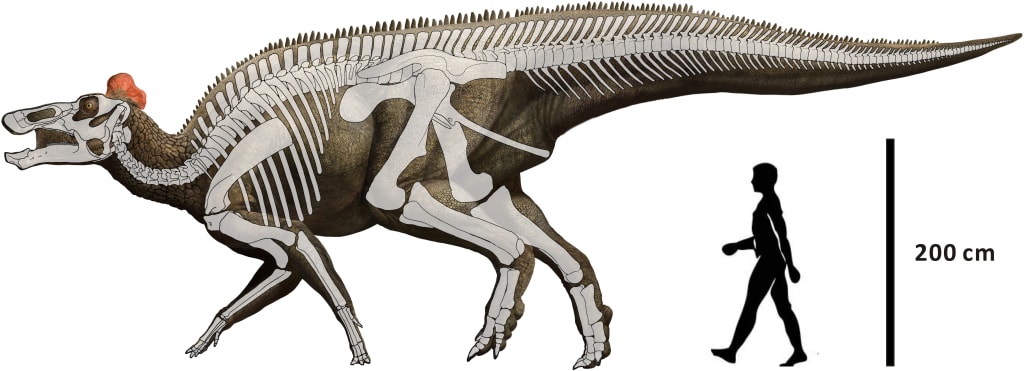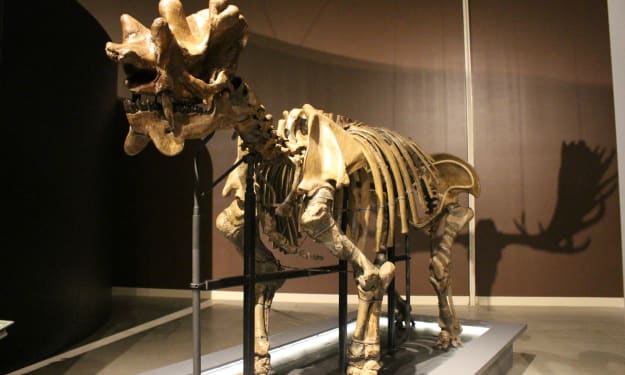The Dead Zoo: Edmontosaurus
New discoveries have significantly altered this oft-overlooked dinosaur.

Dinosaurs are always changing. Even if bones have been pieced together and reconstructed in more or less in their present configurations for decades now, studies of those bones and additional fossils are continuing to alter what we think the “terrible lizards” looked like. And while I’m all in favor of new investigations bringing us dinosaurs in greater detail than ever before, I have to admit that sometimes science makes old favorites look a little… silly.
For one hundred years, Edmontosaurus has been the very model of a massive duckbilled dinosaur. Others of its kind were more ornate – like the tube-crested fan favorite Parasaurolophus – but the bones of the “Edmonton lizard” have been found in such abundance and to such a degree of completeness that this dinosaur is effectively the banner-carrying member of its dinosaurian branch. You can find fossils and reconstructions of the dinosaur in museums from Los Angeles to New York to Oxford, standing there like a mallard’s dream of what a duck wants to be when it grows up.
Yet Edmontosaurus offers us a paleontological paradox. This herbivorous dinosaur, named by Lawrence Lambe in 1917, is so familiar to us that we assume we know this dinosaur well. The fact of the matter is that Edmontosaurus has been offering us a string of unexpected surprises.
As with almost anything dinosaurian these days, there’s the matter of taxonomy. Paleontologists are always re-examining and revising the relationships of dinosaurs, and it turns out that some dinosaurs once thought to be distinct are instead variations of Edmontosaurus. The immense Anatotitan – once thought to be a gigantic neighbor of Edmontosaurus – has turned out to simply be the rare, fully-mature form of Edmontosaurus. And then there’s Ugrunaaluk, a recently-named dinosaur from Alaska that was originally identified as Edmontosaurus, separated out into a new species, and now seems to be synonymous with Edmontosaurus again.
These changes aren’t just taxonomic bookkeeping. That Edmontosaurus and “Anatotitan” are the same animal tells us that these dinosaurs rarely ever reached their full body size and mature skeletal anatomy. In other words, life was hard for dinosaurs and even those who managed to make it to adulthood died young. The fact that “Ugrunaaluk” is probably Edmontosaurus, too, tells us something about the animal. Rather than being isolated to a small geographic pocket or basin, Edmontosaurus populations ranged far and wide. They really were the “cows of the Cretaceous.”
But that’s not all. Even though Edmontosaurus and its relatives are now, and probably will forever be, called duckbilled-dinosaurs, a fossil on display at the Natural History Museum of Los Angeles shows that these dinosaurs were shovel-beaked. A rare soft-tissue impression reveals that the beak of Edmontosaurus was not smooth and flat, but was a corrugated overhang that jutted down from its snout. (And, naturally, while ducks are toothless, paleontologists have known from the start that Edmontosaurus had a dental battery of diamond-shaped teeth the dinosaurs used to pulverize plant food.) Then came something totally unexpected.
In 2013 paleontologist Phil Bell and colleagues forever changed Edmontosaurus. A unique fossil of Edmontosaurus regalis found in Alberta, Canada showed a strange soft tissue impression atop its skull. This wasn’t skin from the rest of the body that had sloughed off and come to rest in an unusual place. It was a little cap – what the researchers called a comb – made entirely of soft tissues that had escaped fossilization in every other specimen found before. Edmontosaurus didn’t have the delicate bony crests of its cousins, but had substituted a flashy little dome atop its head.
The comb is utterly ridiculous. Edmontosaurus now looks like it’s wearing a beanie that has lost its propeller. The majesty of imagining the multi-ton herbivore walking through the Cretaceous forest is totally undone by that little flag of flesh. And how perfect is that? Dinosaurs did not evolve to our aesthetic tastes. They were living creatures who probably bore all sorts of strange soft tissue decorations of which we as yet know little. Our concerns over whether Edmontosaurus regalis truly looked regal don’t matter to animals 66 million years extinct who had their own agendas for showing off and signaling to each other. I can’t help but laugh every time I see the newly-crowned Edmontosaurus, a perfect reminder of just how wonderful and bizarre dinosaurs were.More profiles in this series:
Tyrannosaurus | Stegosaurus | Uintatherium
About the Creator
Brian Switek
Brian is the author of My Beloved Brontosaurus, Written in Stone, and other books. He also writes the Laelaps blog for Scientific American and publishes on fossil discoveries in outlets from Smithsonian to the Wall Street Journal.






Comments
There are no comments for this story
Be the first to respond and start the conversation.